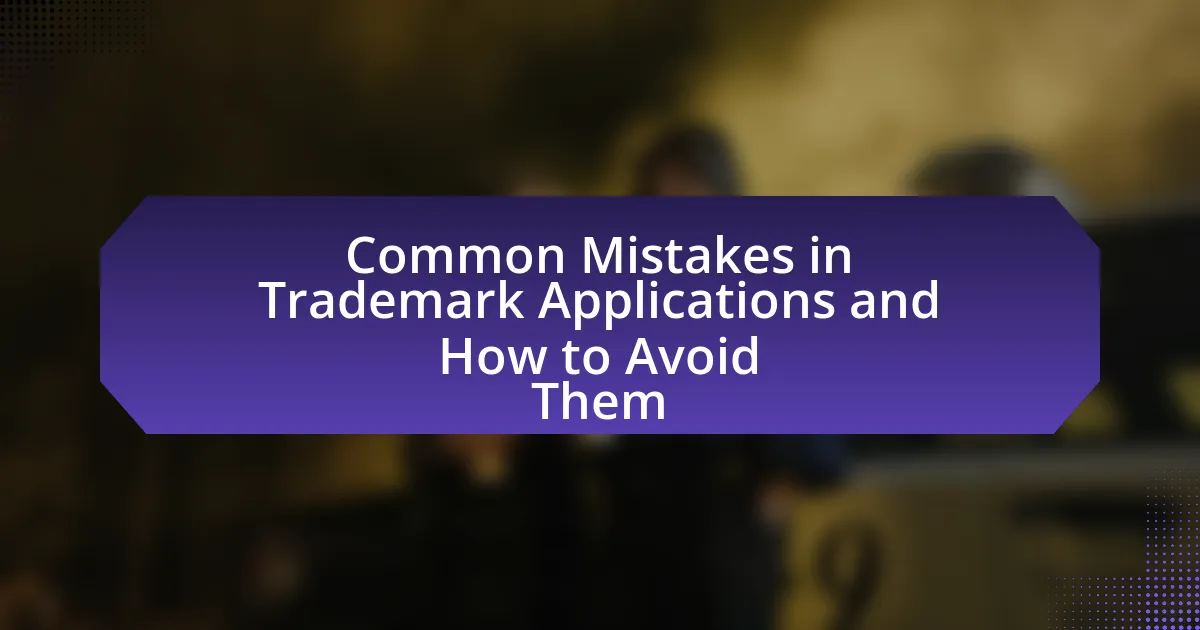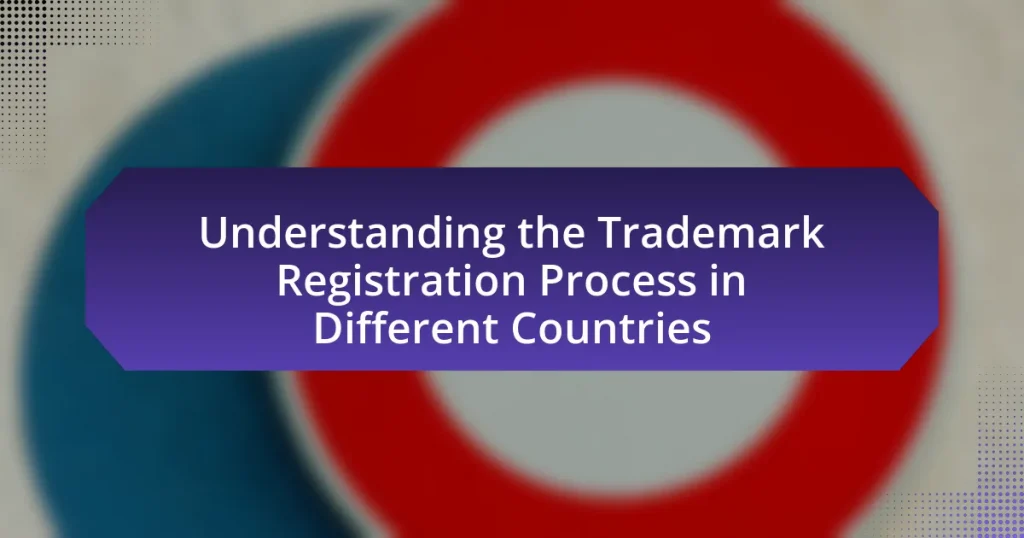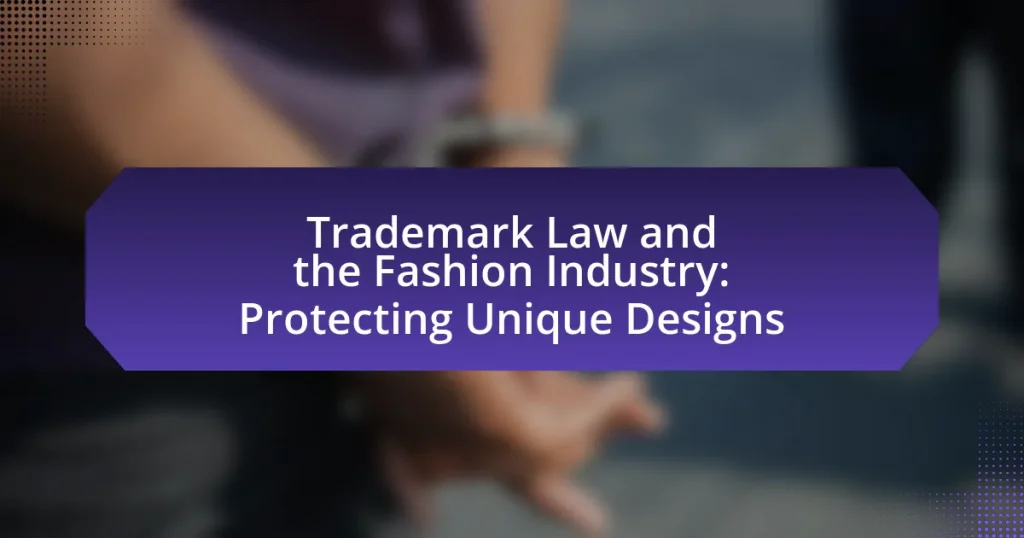The article focuses on common mistakes in trademark applications and strategies to avoid them. Key issues include failing to conduct comprehensive trademark searches, inaccurately describing goods or services, and neglecting to provide adequate evidence of use. It highlights the significant impact of these errors on the registration process, including delays and potential rejections, with approximately 50% of applications facing issues due to misunderstandings of trademark law. The article emphasizes the importance of thorough preparation, legal guidance, and adherence to application guidelines to enhance the chances of successful trademark registration.
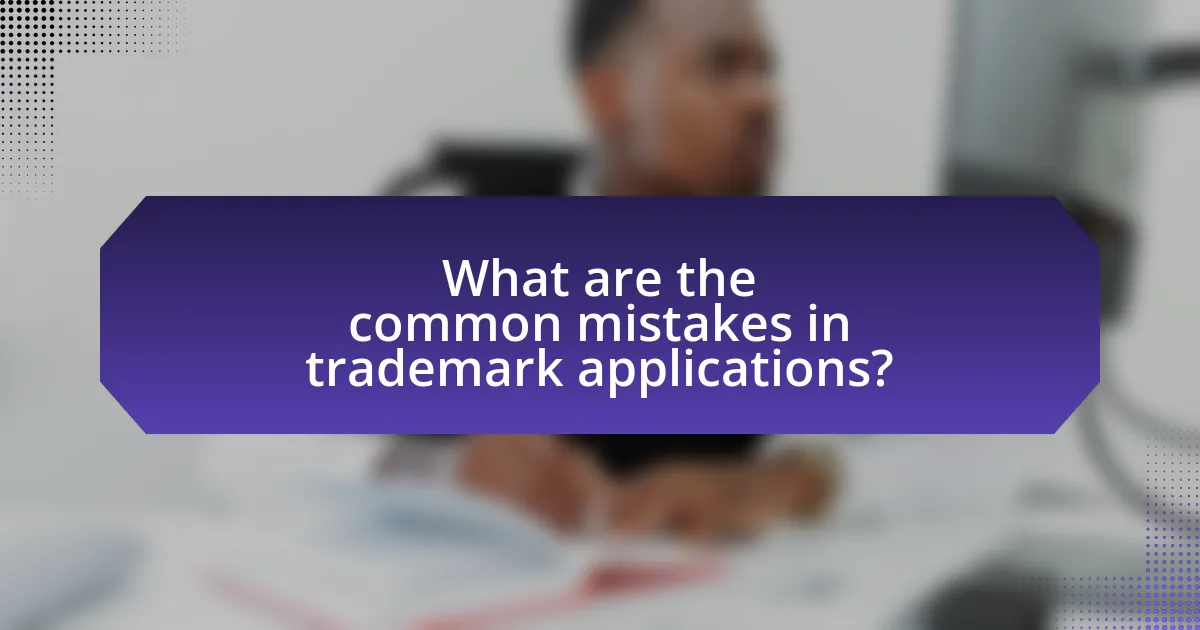
What are the common mistakes in trademark applications?
Common mistakes in trademark applications include failing to conduct a comprehensive trademark search, which can lead to conflicts with existing trademarks. Applicants often overlook the importance of accurately describing the goods or services associated with the trademark, resulting in a lack of clarity that can hinder the application process. Additionally, many applicants neglect to provide sufficient evidence of use or intent to use the trademark in commerce, which is crucial for registration. Errors in the application form, such as incorrect classifications or misspellings, can also lead to delays or rejections. According to the United States Patent and Trademark Office, these mistakes are among the leading causes of application refusals, emphasizing the need for thorough preparation and attention to detail.
Why do applicants make mistakes in trademark applications?
Applicants make mistakes in trademark applications primarily due to a lack of understanding of the legal requirements and complexities involved in the process. Many applicants are unaware of the specific criteria for trademark eligibility, such as distinctiveness and non-descriptiveness, leading to improper classifications. Additionally, incomplete or inaccurate information, such as incorrect descriptions of goods or services, can result in rejections. Research indicates that approximately 50% of trademark applications face issues due to these common errors, highlighting the importance of thorough preparation and understanding of trademark law.
What are the most frequent errors in the application process?
The most frequent errors in the application process for trademarks include incomplete applications, incorrect classification of goods or services, and failure to provide adequate specimens of use. Incomplete applications often lead to delays or outright rejections, as all required fields must be filled accurately. Incorrect classification can result in the trademark not being protected in the intended categories, which undermines the purpose of the application. Additionally, failure to provide adequate specimens of use can demonstrate that the trademark is not being used in commerce, leading to potential abandonment of the application. These errors are commonly cited in trademark examination reports, highlighting their prevalence and impact on the success of trademark registration.
How can misunderstanding trademark law lead to mistakes?
Misunderstanding trademark law can lead to mistakes such as improper filing, infringement, and loss of rights. For instance, businesses may incorrectly assume that a trademark is available when it is already registered, resulting in legal disputes and potential financial losses. According to the United States Patent and Trademark Office, over 50% of trademark applications are rejected due to errors, often stemming from a lack of understanding of the law. This highlights the importance of thorough research and legal guidance in the trademark application process to avoid costly mistakes.
What impact do these mistakes have on trademark registration?
Mistakes in trademark applications can lead to significant delays or outright rejections of the registration process. For instance, errors such as incorrect descriptions of goods or services, failure to provide required specimens, or improper classification can result in the United States Patent and Trademark Office (USPTO) issuing office actions that require additional responses, extending the timeline for approval. According to the USPTO, approximately 40% of trademark applications face issues that necessitate further examination, which can hinder a business’s ability to secure brand protection and market presence effectively.
How can mistakes delay the trademark registration process?
Mistakes can significantly delay the trademark registration process by causing applications to be rejected or requiring additional clarification. For instance, errors in the applicant’s name, incorrect classification of goods or services, or failure to provide necessary documentation can lead to examination delays. According to the United States Patent and Trademark Office (USPTO), approximately 40% of trademark applications face issues that necessitate further action, which can extend the registration timeline by several months or even years.
What are the potential financial implications of errors in applications?
Errors in applications can lead to significant financial implications, including increased costs for re-filing, potential loss of trademark rights, and legal expenses associated with disputes. For instance, a study by the United States Patent and Trademark Office indicates that improper filings can result in fees exceeding $1,000 for corrections and additional submissions. Furthermore, if a trademark application is rejected due to errors, the applicant may lose the opportunity to secure exclusive rights to their brand, which can lead to lost revenue and market share. In 2020, the average cost of trademark litigation was reported to be around $300,000, highlighting the financial risks associated with application errors.
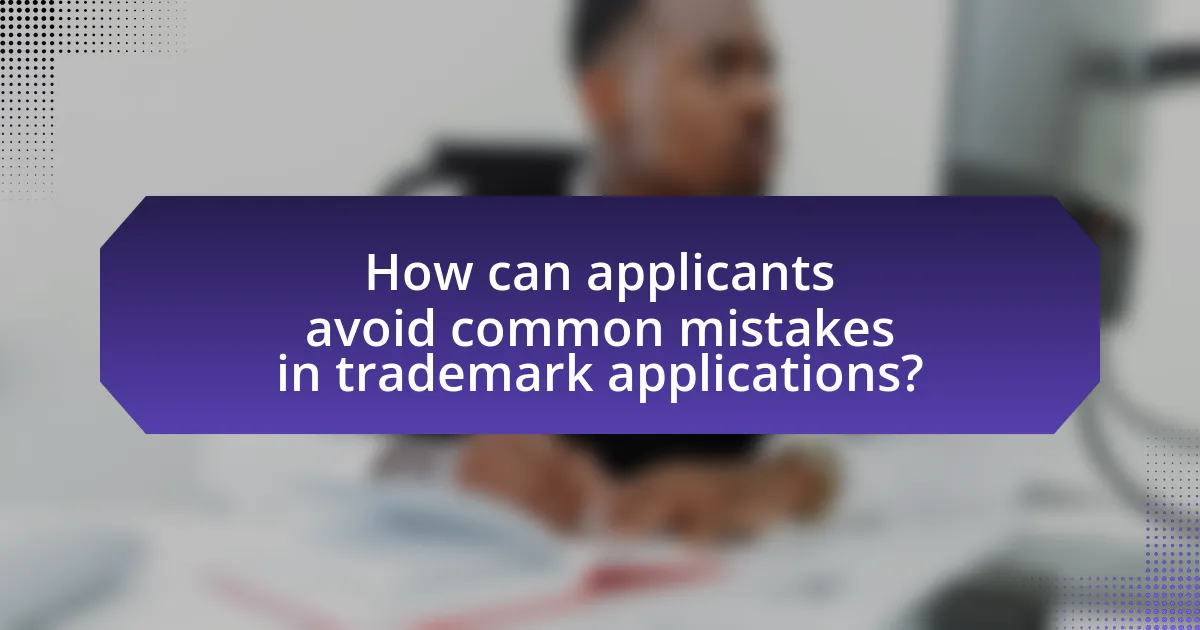
How can applicants avoid common mistakes in trademark applications?
Applicants can avoid common mistakes in trademark applications by conducting thorough research on existing trademarks and ensuring their application is complete and accurate. Conducting a comprehensive trademark search helps identify potential conflicts with existing marks, which can prevent rejection or legal disputes. Additionally, applicants should carefully follow the application guidelines provided by the trademark office, as incomplete or incorrect submissions are a frequent cause of delays and rejections. According to the United States Patent and Trademark Office, approximately 50% of trademark applications are initially rejected due to errors or omissions, highlighting the importance of diligence in the application process.
What steps should be taken before submitting a trademark application?
Before submitting a trademark application, conduct a comprehensive trademark search to ensure that the desired mark is not already in use or registered by another entity. This step is crucial because it helps identify potential conflicts that could lead to legal disputes or application rejections. According to the United States Patent and Trademark Office (USPTO), conducting a thorough search can include checking the Trademark Electronic Search System (TESS) and other databases to confirm the uniqueness of the mark. Additionally, consider consulting with a trademark attorney to navigate the complexities of trademark law and to ensure that the application is properly prepared and filed.
How can conducting a trademark search prevent errors?
Conducting a trademark search can prevent errors by identifying existing trademarks that may conflict with a new application. This proactive step helps applicants avoid potential legal disputes, rejections, or costly rebranding efforts. According to the United States Patent and Trademark Office, over 50% of trademark applications are rejected due to conflicts with existing marks. By performing a thorough search, applicants can ensure their proposed trademark is unique and compliant, thereby reducing the likelihood of application errors and enhancing the chances of successful registration.
What resources are available for understanding trademark requirements?
Resources available for understanding trademark requirements include the United States Patent and Trademark Office (USPTO) website, which provides comprehensive guidelines and educational materials on trademark registration. The USPTO offers a Trademark Basics section, detailed application instructions, and access to the Trademark Electronic Application System (TEAS). Additionally, the World Intellectual Property Organization (WIPO) provides international trademark resources, including treaties and guidelines for global trademark protection. Legal textbooks and online courses on intellectual property law also serve as valuable resources for in-depth understanding of trademark requirements.
What best practices should be followed during the application process?
During the application process for trademarks, it is essential to conduct thorough research on existing trademarks to avoid conflicts. This includes searching the United States Patent and Trademark Office (USPTO) database to ensure that the desired trademark is not already registered or in use. Additionally, applicants should provide a clear and accurate description of the goods or services associated with the trademark, as vague descriptions can lead to rejections.
Furthermore, it is advisable to seek legal counsel or assistance from a trademark attorney to navigate complex legal requirements and ensure compliance with all regulations. According to the USPTO, applications that are prepared with the help of an attorney are less likely to face issues during examination. Lastly, applicants should carefully review their application for errors before submission, as mistakes can result in delays or denials.
How can applicants ensure accurate descriptions of goods and services?
Applicants can ensure accurate descriptions of goods and services by conducting thorough research and using precise language. This involves identifying the specific nature of the goods or services, understanding their intended use, and referencing established classifications, such as the Nice Classification system, which categorizes goods and services for trademark registration. Accurate descriptions help avoid common mistakes in trademark applications, such as ambiguity or overgeneralization, which can lead to application rejections. Additionally, consulting with legal professionals or trademark experts can provide further guidance, ensuring that descriptions align with legal standards and industry practices.
What role does legal advice play in avoiding mistakes?
Legal advice plays a crucial role in avoiding mistakes during trademark applications by providing expert guidance on compliance with legal requirements. Attorneys specializing in intellectual property can identify potential pitfalls, such as improper classifications or inadequate descriptions of goods and services, which could lead to application rejections or disputes. For instance, a study by the United States Patent and Trademark Office indicates that applications with legal representation are significantly less likely to face objections compared to those submitted without legal counsel. This underscores the importance of legal advice in navigating the complexities of trademark law and ensuring a smoother application process.
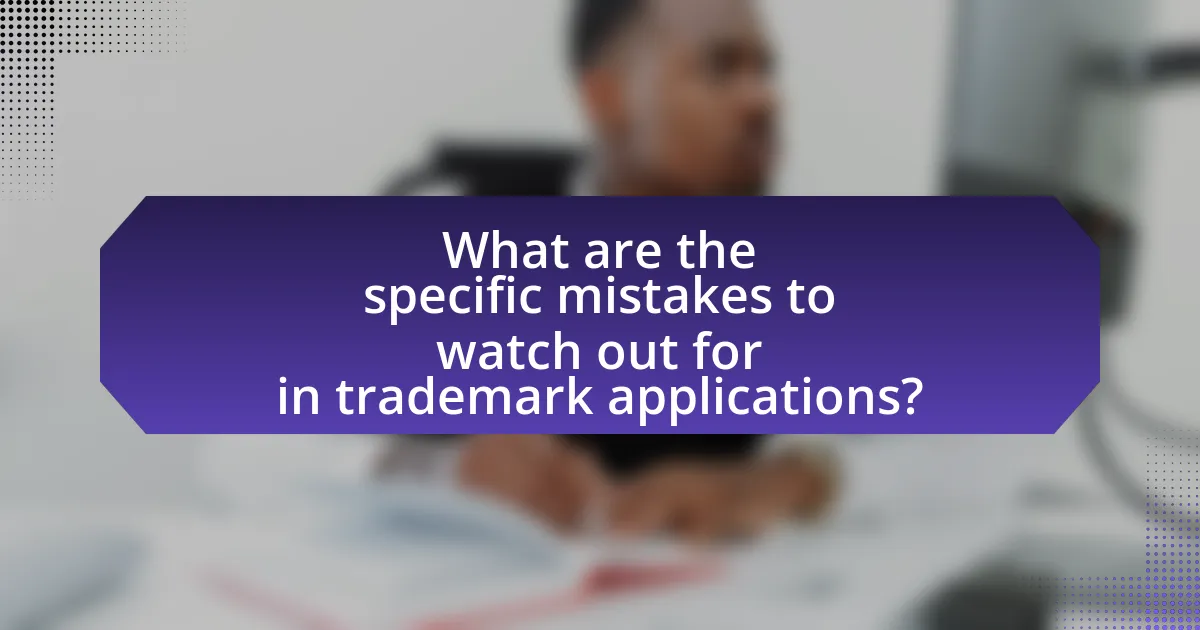
What are the specific mistakes to watch out for in trademark applications?
Specific mistakes to watch out for in trademark applications include failing to conduct a comprehensive trademark search, which can lead to conflicts with existing trademarks. Additionally, applicants often incorrectly describe the goods or services associated with the trademark, which can result in rejection. Another common mistake is submitting an application without proper specimens showing the trademark in use, as the United States Patent and Trademark Office requires evidence of actual use in commerce. Furthermore, applicants may overlook the importance of selecting a strong trademark, opting for generic or descriptive terms that are not protectable. Lastly, failing to respond timely to office actions or requests for additional information can jeopardize the application process. These mistakes can significantly hinder the chances of successful trademark registration.
What are the common filing errors in trademark applications?
Common filing errors in trademark applications include incorrect identification of goods or services, failure to provide a proper specimen, and incomplete or inaccurate applicant information. Incorrect identification can lead to rejection, as the application must clearly specify the goods or services associated with the trademark. A proper specimen is required to demonstrate the trademark’s use in commerce; without it, the application may be deemed insufficient. Additionally, incomplete or inaccurate applicant information can result in delays or denials, as the United States Patent and Trademark Office (USPTO) requires precise details to process applications effectively. These errors collectively contribute to a significant percentage of application rejections, emphasizing the importance of thoroughness and accuracy in the filing process.
How can incorrect classifications lead to application rejection?
Incorrect classifications can lead to application rejection by causing the trademark to be deemed not aligned with the goods or services it intends to represent. When an applicant misclassifies their trademark, it may not meet the legal requirements set by trademark offices, which can result in a failure to adequately protect the mark. For instance, if a food product is classified under a category meant for electronics, the application will likely be rejected due to the mismatch in classification. This is supported by the fact that trademark offices, such as the United States Patent and Trademark Office, have specific classifications that must be adhered to for successful registration.
What are the consequences of failing to provide required information?
Failing to provide required information in trademark applications can lead to application rejection or delays in processing. When essential details are omitted, the trademark office may deem the application incomplete, resulting in a refusal to register the trademark. This can prolong the time it takes to secure trademark protection, potentially allowing competitors to use similar marks. Additionally, applicants may incur extra costs due to the need for resubmission or legal assistance to rectify the application. According to the United States Patent and Trademark Office, incomplete applications are a common reason for delays, emphasizing the importance of thoroughness in the submission process.
How can applicants address mistakes if they occur?
Applicants can address mistakes in trademark applications by promptly identifying the error and filing a correction with the relevant trademark office. This process typically involves submitting a request for amendment or correction, which allows applicants to rectify inaccuracies in their application. For instance, the United States Patent and Trademark Office (USPTO) permits applicants to file a “Request for Correction of Application” to amend details such as the applicant’s name or the description of goods/services. Timely action is crucial, as delays can lead to application abandonment or refusal.
What options are available for correcting errors in a trademark application?
To correct errors in a trademark application, applicants can file a request for correction with the relevant trademark office. This process typically involves submitting a formal request that specifies the errors and the desired corrections. For example, the United States Patent and Trademark Office (USPTO) allows applicants to submit a “Request for Correction of Application” form to amend mistakes such as typographical errors or incorrect classifications. Additionally, if the application has not yet been published for opposition, applicants may be able to make changes directly through the online filing system. These options ensure that the application accurately reflects the intended trademark details, thereby enhancing the likelihood of successful registration.
How can applicants appeal a rejected trademark application?
Applicants can appeal a rejected trademark application by filing a notice of appeal with the Trademark Trial and Appeal Board (TTAB) within six months of the rejection. This process involves submitting a brief that outlines the reasons for the appeal and addressing the specific grounds for rejection stated by the United States Patent and Trademark Office (USPTO). The TTAB will then review the case and issue a decision based on the arguments presented. This procedure is established under the rules set forth by the USPTO, ensuring that applicants have a formal avenue to contest decisions made regarding their trademark applications.
What practical tips can help ensure a successful trademark application?
To ensure a successful trademark application, conduct thorough research on existing trademarks to avoid conflicts. This involves searching the United States Patent and Trademark Office (USPTO) database and other relevant databases to confirm that your desired trademark is not already in use. Additionally, accurately describe the goods or services associated with the trademark, as vague descriptions can lead to rejections. It is also crucial to choose a distinctive trademark, as generic or overly descriptive terms are less likely to be granted protection. Furthermore, consider consulting with a trademark attorney to navigate the complexities of the application process and to ensure compliance with all legal requirements. These steps are supported by the USPTO guidelines, which emphasize the importance of distinctiveness and thorough research in the trademark registration process.
